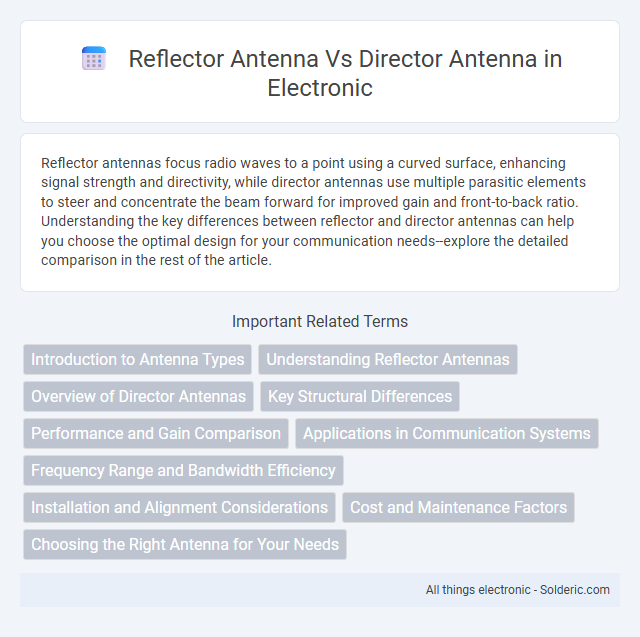Reflector antennas focus radio waves to a point using a curved surface, enhancing signal strength and directivity, while director antennas use multiple parasitic elements to steer and concentrate the beam forward for improved gain and front-to-back ratio. Understanding the key differences between reflector and director antennas can help you choose the optimal design for your communication needs--explore the detailed comparison in the rest of the article.
Comparison Table
| Feature | Reflector Antenna | Director Antenna |
|---|---|---|
| Function | Reflects radio waves to focus the beam | Directs radio waves to increase gain and directivity |
| Position in Antenna Array | Placed behind the driven element | Placed in front of the driven element |
| Effect on Gain | Moderate gain improvement | Higher gain increase than reflector |
| Beamwidth | Wider beamwidth compared to director | Narrower beamwidth for more focused signal |
| Typical Use | Used to enhance backward reflection in Yagi antennas | Used to amplify forward signal in Yagi antennas |
| Physical Design | Larger, curved or flat surface | Smaller, rod-like element |
Introduction to Antenna Types
Reflector antennas use a curved surface, typically parabolic, to focus radio waves to a single point, enhancing signal strength and directivity. Director antennas consist of multiple elements positioned in front of the driven element to guide and sharpen the antenna beam, improving gain and front-to-back ratio. Your choice between these antenna types depends on the desired range, signal clarity, and application requirements.
Understanding Reflector Antennas
Reflector antennas use a curved surface, typically parabolic, to direct radio waves toward a focal point, enhancing signal strength and gain in a specific direction. They are essential in applications requiring high directivity, such as satellite communication and radar systems. Unlike director antennas, which are shorter elements that focus energy forward to increase antenna gain, reflector antennas primarily work by reflecting and concentrating signals.
Overview of Director Antennas
Director antennas are key components in Yagi-Uda arrays, designed to focus radio waves and enhance signal gain by directing energy toward a specific direction. They are typically smaller and positioned in front of the driven element to increase antenna directivity and improve overall transmission performance. Your antenna system benefits from directors by achieving tighter beamwidth and stronger signal reception or transmission in targeted areas.
Key Structural Differences
Reflector antennas feature a curved surface positioned behind the active element to reflect signals forward, enhancing gain and directivity. Director antennas consist of one or more parasitic elements placed in front of the driven element to focus and narrow the beam. Your choice depends on whether you prioritize signal reflection or beam direction for specific communication needs.
Performance and Gain Comparison
Reflector antennas typically provide higher gain and better signal focus due to their parabolic shape, which efficiently directs radio waves to a focal point, making them ideal for long-distance communication. Director antennas, used in Yagi arrays, enhance forward gain by focusing energy in a specific direction but generally offer lower maximum gain compared to reflector antennas. Performance in terms of gain varies with design parameters, where reflector antennas achieve gains often exceeding 20 dBi, while director elements improve gain modestly within multi-element arrays.
Applications in Communication Systems
Reflector antennas are widely used in satellite communication systems for their ability to focus signals into narrow beams, enhancing long-distance data transmission and reception. Director antennas, commonly implemented in Yagi-Uda arrays, improve signal directionality and gain, making them ideal for terrestrial wireless communication, such as TV broadcasting and point-to-point radio links. Your choice between these antennas depends on the required range, signal focus, and application environment in communication systems.
Frequency Range and Bandwidth Efficiency
Reflector antennas typically operate efficiently across a wide frequency range, offering broader bandwidth suitable for applications requiring signal focusing and gain enhancement. Director antennas, commonly used in Yagi-Uda arrays, are optimized for narrow frequency bands, providing improved directivity and gain at specific frequencies but with limited bandwidth efficiency. The choice between reflector and director antennas depends on the desired balance between frequency range coverage and focused signal performance.
Installation and Alignment Considerations
Reflector antennas require precise positioning behind the driven element to maximize signal reflection and focus, often demanding careful alignment to optimize gain and reduce signal loss. Director antennas, typically installed in front of the driven element, need accurate spacing and angling to enhance signal directionality and improve forward gain. Your choice between the two depends on the installation environment and the ease of alignment for optimal antenna performance.
Cost and Maintenance Factors
Reflector antennas generally incur higher initial costs due to their larger size and more complex structural components compared to director antennas, which are simpler and more cost-effective to produce. Maintenance for reflector antennas involves regular inspections and adjustments to ensure the parabolic surface remains precisely aligned, often requiring skilled technicians. Director antennas demand less frequent maintenance due to their simpler design, resulting in lower ongoing operational expenses.
Choosing the Right Antenna for Your Needs
Reflector antennas excel in focusing signals by reflecting energy toward the main lobe, making them ideal for long-range communication and high gain applications. Director antennas, equipped with multiple parasitic elements, enhance directivity and front-to-back ratio, best suited for shorter range or directional signal targeting. Your choice depends on whether you prioritize maximum gain with a reflector antenna or improved directionality and compact design with a director antenna.
reflector antenna vs director antenna Infographic

 solderic.com
solderic.com